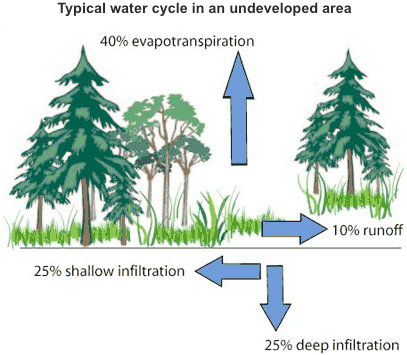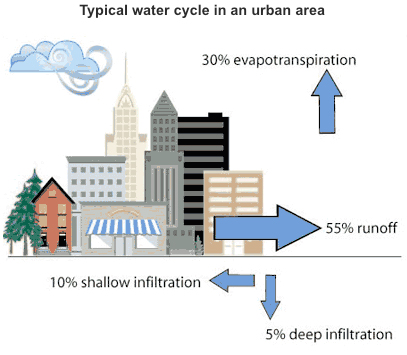

The Issue: Shrinking Wetlands and Aquatic Habitats
Urbanization has vastly affected the environment around us. What used to be a prairie or a savannah became asphalt roads and driveways, and instead of preserving our forests, we have replaced them with skyscrapers and office buildings. This drastic alteration of the landscape has also had a profound affect on the water cycle.
Before Urbanization: The Natural Water Cycle


After Urbanization: The Urban Water Cycle
As humans develop the land, they alter its natural composition in exchange for streets, houses, and parking lots. These impervious surfaces greatly disrupt the water cycle. Normally, water would be absorbed by the soil, but since a lot of this soil is being replaced with asphalt, the water is forced to evaporate or run off. According to raingardennetwork.com, when it rains in a natural, undisturbed environment about 50% of the rainwater infiltrates into the ground, 40% evaporates or is taken up by plants and only about 10% runs off the surface.
This extra surface runoff is a major factor in modern floods. Greater amounts of water are entering oceans and streams than ever before. In addition, where we do have soil, such as in residential yards or commercial grounds, it is covered in grass or nonnative plants. These plants all have shallow root systems, and are ineffective in absorbing high amounts of water.
What are we trying to accomplish with our rain garden?
Implementation:
Outline The Plans
To begin, we researched and collected as much information on rain gardens as we could.
We read a variety of print and online sources in order to fully understand what a rain garden is and how it could help our school, and ultimately our community. In addition, we studied a variety of moisture loving plants that we could include in a rain garden of our own. Finally, we sorted through many designs, which served as models for to create one of our own.
After collecting all of the necessary information, we selected a location for our rain garden. Due to recent construction at our school, the landscape has been altered, creating ditches around the creek near our school. One of the ditches, at the bottom of a slope near a parking lot, collects a vast amount of water, especially after storms. In addition to being adjacent to the creek, the edge of the entrenched area is also near a large drain, making it an ideal location for a rain garden.
Next, we determined the area of our plot (about 250 feet squared) and measured it outside. We then drew up a tentative plan that included plants drawn to scale. In addition, we predicted the plant sizes both at the time of planting and at maturity.
Get Approval & Funding
In order to actually plant a rain garden at the school, we had to get the consent of school officials, the groundskeeper, and the city of Ladue. We had multiple meetings with the school principal along with the high school groundskeeper. In addition, we corresponded with Ladue Public Works, a district-affiliated architecture firm located within City Hall.
After receiving approval, we needed to secure adequate funds. We applied for a grant through the high school’s Dad’s Club Association, a fundraising organization that supports student activities. We received $200 to use for supplies, including seeds and plants.
Preparation
To promote a community-wide effort, we enlisted the help of other groups within the high school. For instance, we worked with Elements, Ladue’s environment club, to organize a work force to help install and maintain the rain garden in the future. We also met with Club Mud, Ladue’s ceramics club, to help beautify the garden. Club members will make creative signs with the names of the native plants located in the rain garden to be placed around its perimeter.
Check out the "FAQ & Facts" page for information, statistics, and facts about wetlands.
Check out our "Take Action" page to to learn more about rain gardens and how you can create your own rain garden.
The Plot:
Our Rain Garden Blueprint:
Click on any of the plant names to see a picture of it in our garden.
Currently we do not have our Spice Bushes or the Copper Irises.
Last pictures taken on 3/27/09.
Name |
Height |
Spread |
Desc. of Flowers |
Bloom |
Wildlife Attracted To Plant |
| Red Buckeye | 10'-15' |
6'-10' |
Plume of deep red | Late Spring |
Hummingbirds |
| Button Bush | 6'-8' |
6'-8' |
Creamy white | Jun. - Sept. |
Butterflies, bees, hummingbirds |
| Shining Bluestar | 3'-4' |
3'-4' |
Star-shaped light blue | Spring |
Butterflies |
| Orange Coneflower | 1.5'-2.5' |
2' |
Yellow to orange | Jul. - Sept. |
Butterflies |
| Southern Blue Flag | 2'-3' |
1'-2' |
Blue violet | May - Jun. |
Hummingbirds, insects |
| Soft Rush | 2'-3' |
1'-2' |
None | N/A |
Birds |
| Cardinal Flower | 2'-4' |
1'-1.5' |
Red | Jul. - Oct. |
Hummingbirds, butterflies |
| Copper Iris | 2'-3' |
2'-4' |
Beardless & crestless copper | Late Spring |
Hummingbirds |
| Great Blue Lobelia | 2'-3' |
1'-1.5' |
Dark blue tubular w/2 lips | Jul. - Sept. |
N/A |
| Marsh Milkweed | 3'-4' |
2'-3' |
Pink | Aug. - Sept. |
Butterflies (esp. monarchs) & pollinators |
| Palm Sedge | 2'-3' |
2'-3' |
None | May - Sept. |
Turkeys, pheasant, quails & doves |
| Riddell's Goldenrod | 2'-3' |
1.5'-2' |
Yellow | Sept. - Oct. |
Bees, butterflies |
| Sensitive Fern | 3'-4' |
3'-4' |
None | N/A |
N/A |
| Sweet Coneflower | 3'-5' |
1'-2' |
Fragrant brown & yellow flowers | Jul. - Oct. |
N/A |
| Sneezeweed | 3'-5' |
2'-3' |
Yellow to mottled yellow & orange | Aug. - Oct. |
Butterflies |
| Switchgrass | 3'-6' |
N/A |
Yellow | Mid-Summer |
Rabbits, ducks, pheasants, & quail |
| Spicebush | 9'-15' |
6'-10' |
Fragrant yellow flowers | Late Mar. - Apr. |
Swallowtail butterflies |
| Glade Fern | 2'-3' |
2'-3' |
None | N/A |
N/A |
| Rosemallow | 4'-5' |
3' |
White or pink | Mid-Summer |
Butterflies |
| Purple Coneflower | 2'-3' |
1.5'-2' |
Showy purple | May - Oct. |
Butterflies & birds |
| Tussock Sedge | 1'-1.5' |
1.5'-2.5' |
None | Late Spr.-Early Sum. |
Amphibians, birds, butterflies, & mammals |
Getting The Word Out:
In order to spread the word about our efforts and educate the community about how they can improve the health of their watershed and their yard, we have created this site and used other tools. We were also featured in the November 2008 issue of the Panorama, Ladue High School’s Newspaper. The article discussed our rain garden efforts and the purpose of our team. Over 1000 of these papers were distributed that month at the end of November to students, teachers, and families within and beyond the Saint Louis area. The High School also included a link to our website on the index page.
Sources:
www.floridata.com
www.grownative.org
www.abnativeplants.com
www.raingardennetwork.com
www.missouriwildflowerguide.com
http://edmondok.com/utility/drainage/stormwater101/runoff
